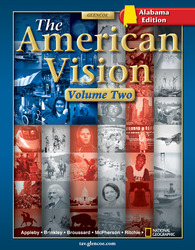The American Vision Volume 2, Alabama EditionChapter/Alabama :
Alabama Special ReportWeb Lesson PlansThe Depression and World War II In this activity, students will examine the circumstances that led to the employment of women as "production soldiers" during World War II. Through their reading, students will gain a better understanding of and a deeper appreciation for the role women played on the home front. Lesson DescriptionStudents will use information from the Redstone Arsenal Web site to learn about the challenges that women faced during World War II. They will read about the circumstances that led to the creation of "production soldiers" and the role they played in the war effort.
Students will read about the struggles and determination of the production soldiers. Students will also learn how the U.S. Army strived to lessen the burden on the women who gave so tirelessly and the methods used to relieve stress and boost morale. After reading the article, students will answer six questions and apply this knowledge to create a World War II poster aimed at recruiting women. Instructional Objectives:- Students will analyze the social, economic, and personal impacts of World War II on American women.
- Students will apply this knowledge to create a World War II recruitment poster.
Student Web Activity Answers- The U.S. Army had a very difficult time recruiting employees for the Huntsville and Redstone Arsenals for several reasons. Perhaps the biggest problem was the scarcity of people with backgrounds in chemistry and the unavailability of supervisory personnel. In addition, the labor market in Alabama was 95 percent agricultural and the type of industrial laborers that were available only had experience in textiles. There was also a sheer lack of personnel to fill clerical and secretarial positions. Other factors that affected recruitment included the migration of more qualified workers to coastal defense plants and the army's inability to compete with higher wages being offered by other employers.
- In addition to taking care of their families and working on production lines, women actively contributed to the war effort in multitudes of ways, including volunteering and rationing. For instance, women sewed, learned first aid, and volunteered at the USO. They formed "bicycle" brigades to conserve gas and rubber tires and led salvage scrap drives. Other efforts included the buying and selling of war bonds and victory gardening.
- The "production soldiers" of Redstone and Huntsville Arsenals worked for economic, personal, and patriotic reasons. Above all, these women felt that working on the production lines was their patriotic duty, helping to win the war and safely return their husbands, fathers, and sons.
- The production soldiers brought feminine touches to their jobs and the workplace in several ways. The women would form sing-a-longs during their shifts and prepare meals to share with coworkers. In addition, the production soldiers had special outfits to wear.
- The U.S. Army helped women balance the challenges of work and home through a variety of programs and initiatives. The Huntsville and Redstone Arsenals established counseling services and the Huntsville Arsenal actually hired a nurse who made house calls, checking on the employees. The U.S. Army helped its employees by finding and building affordable housing. The Army also helped those who needed transportation to and from work. In order for the women to work and complete their errands, such as grocery shopping, the Army convinced local shopkeepers to extend their hours, accommodating the women who worked at the Arsenals. One of the greatest challenges the women faced in balancing work and life was the issue of childcare. The Redstone Arsenal tried for two years-and was at last successful-to gain permission to create a nursery on the premises for the working mothers. However, the war was nearing an end and the nursery wouldn't be needed as the women were let go. Of course, in addition to helping the women balance work and life, the Army's efforts also ensured a higher rate of attendance, which was important to maintain production levels.
- The U.S. Army held after-hours social events such as picnics, dances, and barbeques to help employees to relieve stress and to boost morale. The Army also established sports leagues for employees, however, most were too busy to join any after-work social events.
- After students have created their posters, use class time to review each poster. Ask students to explain the meaning behind the visuals they chose for their poster. Display the posters in the classroom.
 |  |


















